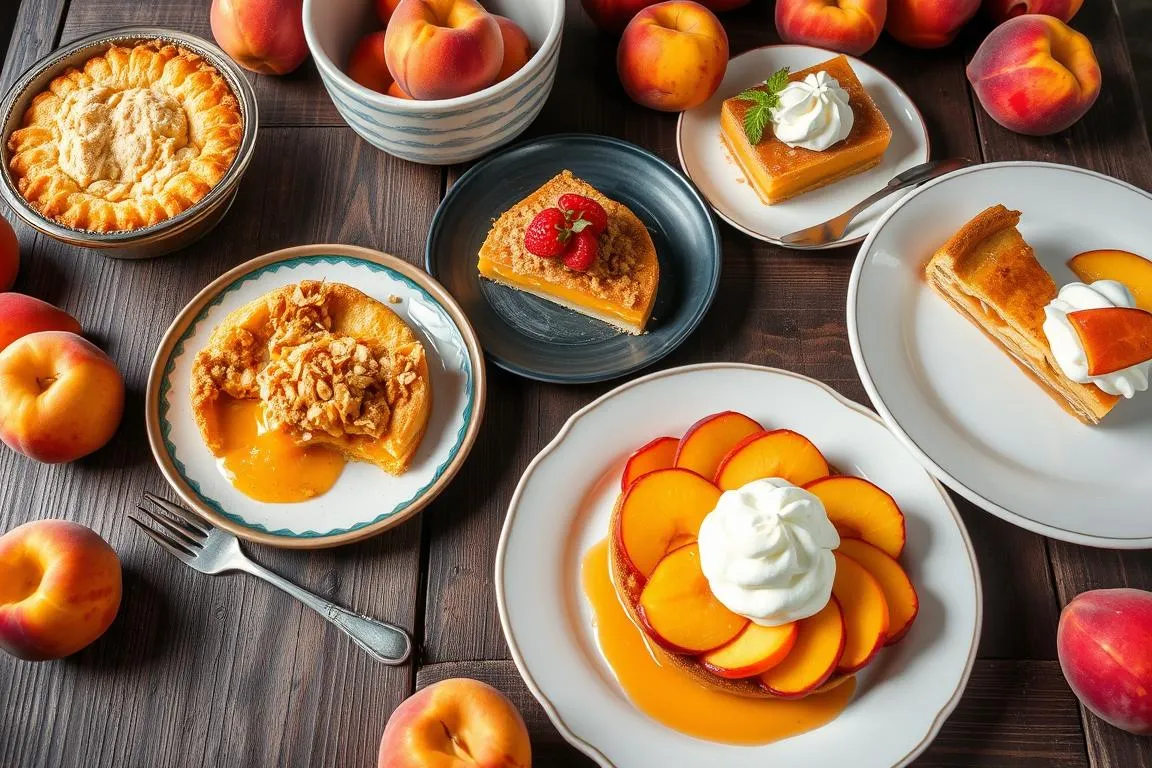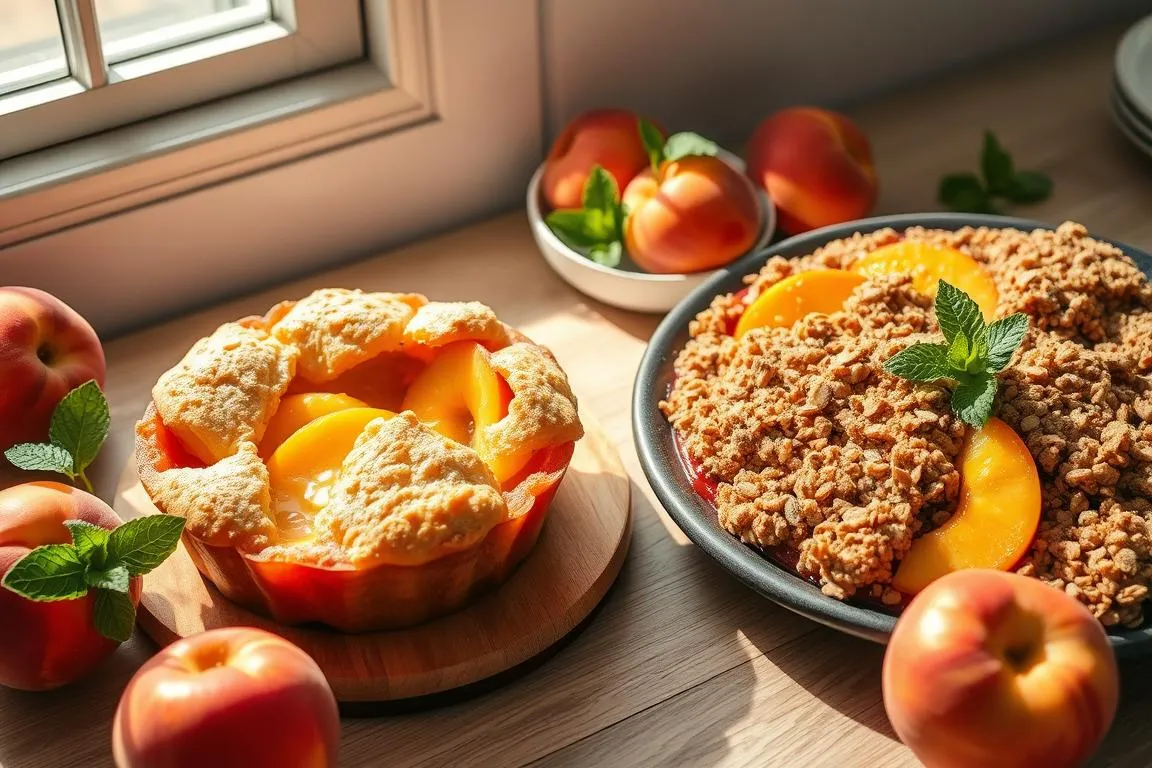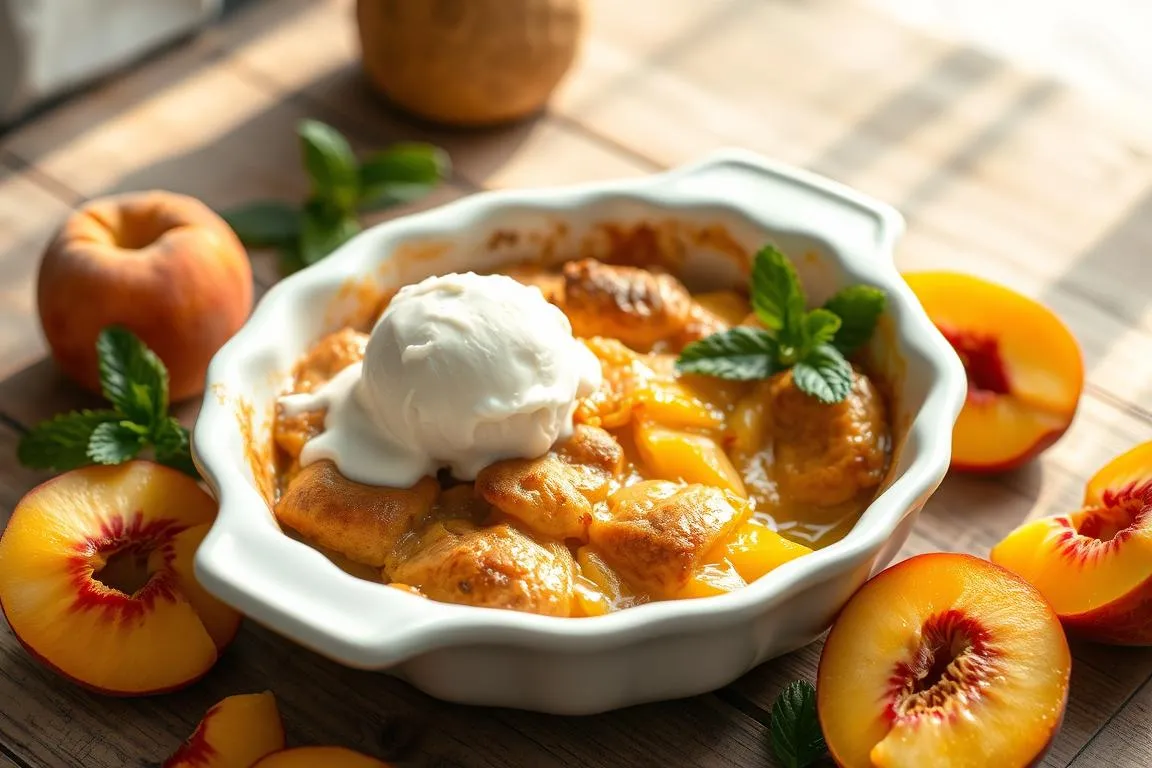Peach cobbler and crumble are two classic fruit desserts loved by many in the United States. They might look similar at first, but they have interesting differences. These differences make each dessert special in its own way.
Many home bakers and dessert lovers wonder about the differences between these two desserts. Both use ripe, juicy peaches and offer a mix of soft fruit and crispy topping. Yet, they each have their own unique flavor and style.
Key Takeaways
- Peach cobbler and crumble share similar fruit bases but differ in preparation
- Understanding their unique characteristics enhances baking skills
- Both desserts originate from rich culinary traditions
- Texture and topping are critical distinguishing factors
- Regional variations add depth to these classic desserts
What’s the difference between a peach cobbler and a crumble
Peach desserts are a joy to make and eat. But, many people get confused between cobblers and crumbles. Knowing the difference helps bakers make the perfect peach dessert.
Key Structural Elements
The main difference is in the topping. Cobblers have a biscuit or cake layer on top of the fruit. This layer is rough and uneven. Crumbles, on the other hand, have a streusel topping made from flour, butter, and sugar. This topping is crumbly and structured.
- Cobbler: Biscuit or cake-like topping
- Crumble: Streusel-style crumbly layer
- Both highlight fresh peaches as the star ingredient
Topping Variations
The way you top the dessert changes everything. Cobblers can have biscuit tops that are dropped or rolled. Crumbles offer a variety of textures with different mixing methods.
| Dessert Type | Topping Characteristics | Texture Profile |
|---|---|---|
| Cobbler | Soft, cake-like dough | Tender, slightly dense |
| Crumble | Crisp, granular mixture | Crunchy, sandy |
Traditional Preparation Methods
Each dessert has its own way of being made. Cobblers are made by layering biscuit dough on fruit. Crumbles need butter mixed into dry ingredients for that crumbly texture.
“The magic of these desserts lies in their simplicity and celebration of fresh peaches.” – Southern Baking Traditions
The History and Origins of Peach Cobbler
Peach cobbler is a tasty part of American dessert history. It comes from the Southern United States. Early settlers made it with simple ingredients because they had to.
The story of peach cobbler shows how American cooking changed. Settlers used European baking methods to make a quick dessert with fresh fruits. The name “cobbler” comes from the pastry’s rough look.
“A true Southern peach cobbler tells a story of resourcefulness and delicious innovation.” – Southern Culinary Historian
- Early settlers developed cobbler as a quick, resourceful dessert
- Peaches were abundant in Southern agricultural regions
- The dish represented a practical solution for preserving fruit
- Cooking methods reflected limited kitchen equipment of the time
In the 19th century, peach cobbler became a Southern favorite. Families would come together to enjoy it. It showed off the area’s fruit and was a sign of warmth and welcome.
Over time, families made their own versions of cobbler. They passed down these recipes, keeping peach cobbler alive in American cooking.
Understanding the Crumble’s British Roots
The history of the British crumble is a tale of culinary creativity. It shows how simple ingredients became a favorite dessert. This journey began in tough times, where British cooks used their skills to make do with less.
World War II brought food rationing to Britain. Making traditional fruit pies was hard because of the lack of ingredients. But, cooks found a way to make a tasty crumble using less butter and flour.
Evolution of the Crumble During Wartime
- Rationing led to creative cooking
- Less butter and flour were used
- Simple ingredients became key
The crumble became a smart choice for desserts. It used fruits in season, a bit of fat, and basic pantry items. This made a delicious treat without using much.
Modern Interpretations
Today, chefs are making the crumble their own. They add new twists with exotic fruits and special toppings. This has made the crumble a fancy dish in fancy restaurants.
| Era | Crumble Characteristics |
|---|---|
| 1940s Wartime | Basic ingredients, minimal waste |
| 1960s-1970s | Standardized home recipes |
| Modern Day | Gourmet variations, global ingredients |
Regional Variations
Across Britain, different crumbles have their own flavors. Yorkshire might add oats, while Cornwall could use local fruits like blackberries or apples.
“The crumble represents more than a dessert—it’s a testament to British culinary ingenuity.” – British Food Historian
Essential Ingredients for the Perfect Peach Cobbler
Making a delicious peach cobbler starts with picking the right ingredients. You need fresh, ripe peaches and quality baking essentials. These turn simple ingredients into a tasty treat.
The secret to a great peach cobbler is knowing the key ingredients. Let’s look at the must-haves for a standout dessert:
- Fresh, ripe peaches (preferably local or seasonal)
- All-purpose flour for the perfect topping
- Unsalted butter (high-quality recommended)
- Granulated and brown sugar
- Ground cinnamon and nutmeg
- Vanilla extract
- Pinch of salt
Choose peaches that are firm but slightly soft when pressed. Freestone peaches are best because they’re easy to pit.
“The secret to an outstanding peach cobbler is using the freshest ingredients and treating them with care.” – Professional Baker’s Wisdom
For your cobbler, use precise measurements and high-quality ingredients. A mix of sweet and tart flavors will make a dessert that everyone will love.
| Ingredient | Purpose | Recommended Quantity |
|---|---|---|
| Fresh Peaches | Primary Fruit Base | 4-5 medium peaches |
| Flour | Topping Structure | 1 cup |
| Butter | Richness and Texture | 1/2 cup, cold |
| Granulated Sugar | Sweetness | 3/4 cup |
Remember, precision is key when preparing peach cobbler ingredients. Measure carefully and use room temperature ingredients for the best results.
Making a Classic Peach Crumble: Ingredients and Technique
Making the perfect peach crumble needs care, love, and some special baking tricks. This dessert mixes juicy peaches with a crunchy, buttery top. It’s a treat that will make your taste buds happy.
Choosing the Right Peaches
Picking the right peaches is key for a great crumble. Look for these signs:
- Ripe but firm peaches with vibrant color
- Fragrant aroma indicating peak ripeness
- Slight give when gently pressed
Creating the Perfect Crumb Topping
The secret to a top-notch peach crumble is in the topping. Here’s how to get it right:
- Use cold butter cut into small cubes
- Mix flour, sugar, and butter until crumbly
- Add a pinch of salt for enhanced flavor
Baking Tips and Techniques
Learning the right crumble baking techniques makes every dessert a hit. Follow these expert tips:
| Technique | Details |
|---|---|
| Oven Temperature | 375°F (190°C) for even baking |
| Baking Time | 40-45 minutes until golden brown |
| Topping Consistency | Coarse, pea-sized crumbs |
“A great peach crumble is about balance: sweet fruit, crispy topping, and perfect baking technique.”
Pro tip: Let your peach crumble rest for 15 minutes after baking. This lets the filling set and flavors blend perfectly.
Serving Suggestions and Pairings
To make your peach cobbler or crumble special, think about what to serve with it. The right sides can turn these desserts into unforgettable moments.
- Classic Cold Companions
- Vanilla bean ice cream
- Homemade whipped cream
- Clotted cream
- Beverage Pairings
- Chilled dessert wine
- Bourbon-based cocktails
- Strong black coffee
“A perfectly served dessert is an art form that delights all senses.” – Chef Maria Rodriguez
Temperature is key when serving these desserts. Warm cobbler or crumble right after baking keeps it crispy and flavorful.
| Serving Style | Best Temperature | Recommended Garnish |
|---|---|---|
| Warm Cobbler | 110-120°F | Fresh mint leaves |
| Room Temperature Crumble | 68-72°F | Toasted almond slivers |
| Chilled Dessert | 40-45°F | Caramel drizzle |
Remember, how you present matters! Use rustic dishes for a cozy feel or elegant glass bowls for a fancy touch.
Common Mistakes to Avoid When Making Either Dessert
Making peach desserts can be tricky, even for experts. Knowing common mistakes in cobblers and crumbles helps you get it right every time.
Texture Troubleshooting Challenges
Texture problems often lead to soggy toppings in cobblers and crumbles. To avoid this, focus on preparation and baking techniques. Here are some tips for the perfect texture:
- Pre-cook fruit filling to reduce excess moisture
- Use cornstarch or flour to thicken fruit juices
- Avoid overloading the dessert with liquid ingredients
Temperature Control Techniques
Getting the temperature right is key to making great peach desserts. The right temperature ensures even cooking and the best texture.
| Temperature Issue | Solution |
|---|---|
| Underbaked topping | Increase oven temperature by 25°F |
| Burned edges | Cover with aluminum foil halfway through baking |
| Soggy bottom | Preheat baking sheet before placing dessert |
Storage and Reheating Best Practices
Proper storage keeps your peach dessert fresh for days. Refrigerate within two hours of cooking, and cover well to keep moisture in.
“The secret to great peach desserts is not just in the baking, but in how you preserve and reheat them.” – Professional Baker’s Tip
- Store in airtight container for up to 3 days
- Reheat at 350°F for 10-15 minutes
- Add fresh crumble topping after reheating for extra crispness
Mastering these tips will improve your cobbler and crumble making. You’ll create treats that wow everyone.
Regional Variations and Modern Twists
Peach desserts have changed a lot in different places. They’ve turned old cobbler and crumble recipes into new, exciting dishes. Chefs and home bakers in the South and California’s wine country are making these classics their own.
Now, desserts use special local ingredients. This brings out unique tastes. Here are some cool examples:
- Southern Bourbon Peach Cobbler – Adds Kentucky bourbon for extra sweetness
- California Lavender Peach Crumble – Uses local lavender for a floral touch
- Texas Jalapeño Peach Cobbler – Adds a spicy twist to the sweet dessert
Today’s bakers are making desserts without gluten and animal products. They use almond or coconut flour instead of wheat. And they use plant-based butters for that crumbly texture we love.
“Innovation in desserts comes from respecting tradition while daring to experiment” – Chef Maria Rodriguez
People are also making desserts healthier. Chefs are using less sugar and sweeteners like honey. They add nuts and seeds to the topping for extra nutrition.
These new takes on old desserts show that classics can be both familiar and fresh. They encourage home bakers to get creative in their kitchens.
Conclusion
Exploring peach cobbler vs crumble is a tasty journey through food traditions and tastes. These desserts turn fresh peaches into yummy treats that everyone loves.
Both desserts love sweet, baked fruit, but they make it differently. The cobbler has a biscuit-like top, a classic in America. The crumble, from Britain, has a streusel topping that’s crunchy and perfect with peaches. Each dessert has its own story of culture and creativity.
Now you can make both peach cobbler and crumble with ease. You might prefer the soft cobbler or the crunchy crumble. Either way, these desserts are a chance to try new things and enjoy your baking.
The best part of these desserts is how simple they are. They make seasonal peaches into something amazing. So, enjoy baking, try both, and relish every bite of your homemade treat.
FAQ
What is the main difference between a peach cobbler and a peach crumble?
The main difference is in the topping. Peach cobbler has a biscuit-like or cake-like topping. Peach crumble has a streusel topping made from flour, butter, and sugar.
Are peaches the only fruit I can use in these desserts?
No, you can use other fruits too. Apples, berries, cherries, or mixed fruits work well. The method is the same, no matter the fruit.
What is the origin of peach cobbler?
Peach cobbler comes from American Southern cuisine. It was a simple dessert made with what settlers had. It’s a big part of Southern cooking.
Where did the crumble originate?
The crumble comes from Britain. It became popular during World War II. It was a way to make a tasty dessert with few ingredients.
Can I make these desserts gluten-free?
Yes, you can! Use gluten-free flours like almond or coconut flour. This way, people with gluten issues can enjoy these desserts.
What are the best peaches to use for these desserts?
Use Freestone peaches for cobblers and crumbles. They’re easy to pit and slice. Elberta, Red Haven, or Georgia Belle peaches are great choices.
How do I prevent my cobbler or crumble topping from becoming soggy?
Make sure your fruit isn’t too wet. Use thickeners like cornstarch. Bake at 375°F and don’t cover it to keep the topping crisp.
Can I prepare these desserts in advance?
Yes, you can prepare them ahead. Assemble and refrigerate or bake and reheat later. Store in an airtight container to keep it fresh.
What are the best serving suggestions for peach cobbler or crumble?
Serve warm with vanilla ice cream, whipped cream, or caramel sauce. Some like it with cinnamon or fresh cream.
How long can I store leftover cobbler or crumble?
Store in an airtight container in the fridge for 3-4 days. Reheat at 350°F for 10-15 minutes to crisp the topping.



